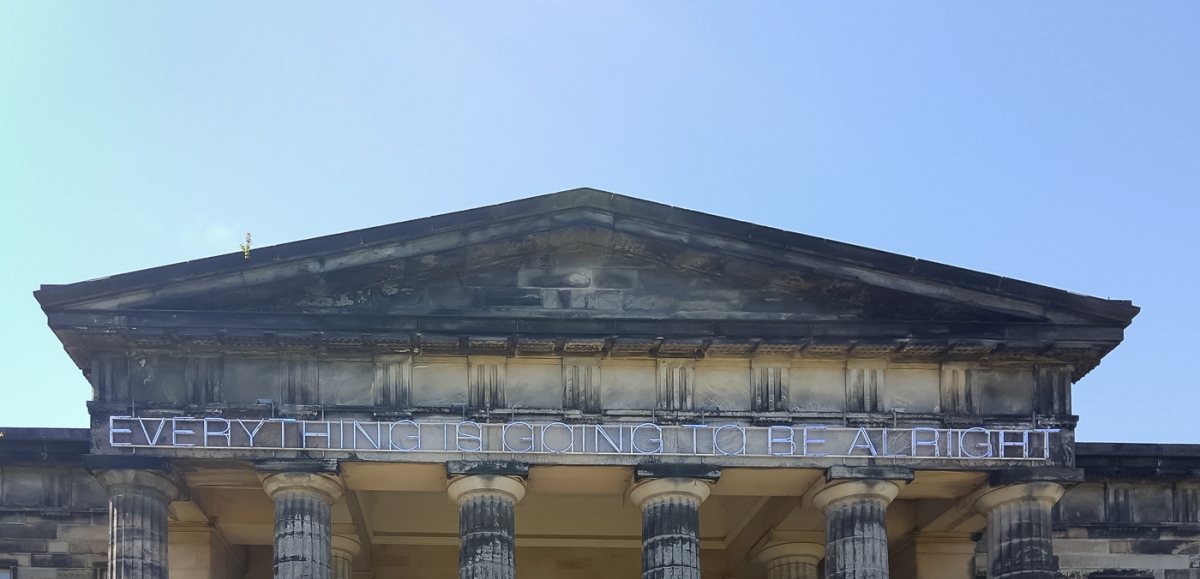I usually try, when up home, to visit an exhibition or two and as Edinburgh has a wealth of galleries, I am not usually disappointed. This time however most of the major galleries seemed to be between exhibitions so on my one day off from ‘mother duties’ I headed to a gallery, or two to be exact, that I hadn’t visited before.
The Scottish National Gallery of Modern Art is a little further away from the centre than the other major galleries and there is a bus that runs between the other National Galleries but as it was a nice day, I decided to walk the 25 or so minutes from the centre. I knew little about this (these) galleries except that there is currently a exhibition of work by Andy Warhol and Eduardo Paolozzi, ‘I Want to be a Machine’, in Modern Two, and I understood some work by Douglas Gordon in Modern One and as Douglas Gordon specialises in ‘text’ art, the subject of my assignment 4, critical review, I was interested to see some of his work in the flesh so to speak.
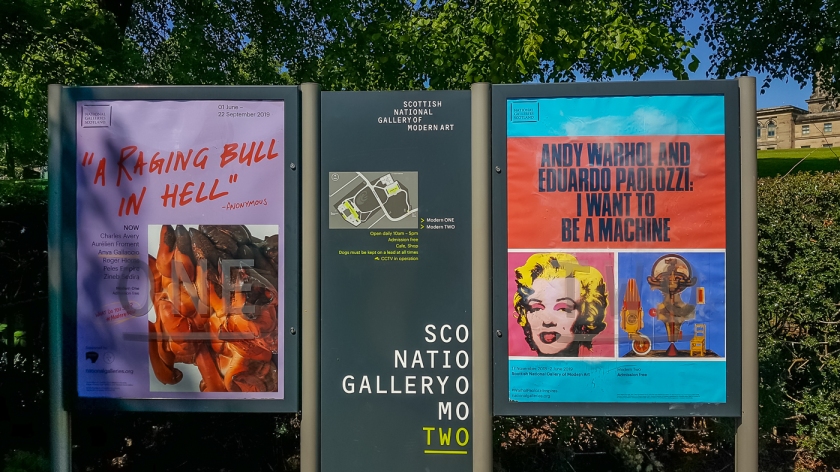
Modern One and Modern Two as they are known, sit facing each other in parkland separated by a main road and as I reached Two first, that was my first port of call.

The first thing you notice are the sculptures on the lawn in front of the gallery and a large installation bearing the words ‘There will be no Miracles Here’, which I wrongly attributed to Douglas Gordon. In fact, this work is by Nathan Coley
I wrongly assumed that the large installation ‘There will be no miracles here’, see Fig. 2, would be Douglas Gordon’s but no, this is by Nathan Coley, another Scot, who, going by his website is another artist worth exploring further as there is a mix of photography, text and as he calls it, ‘other stuff’.

The mirror installation in Figure 3 is interesting and I struggled to find anything about this, either where it was installed or on the gallery website. However, further research reveals that this is a ‘Two-way Mirrored Parallelogram’, by Dan Graham. In the audio link, here, we hear someone from the gallery talking about how the sculpture was made and how it works. One of the things that I found strange and slightly unsettling about it was that it was really hard to take a photograph of the sculpture without getting myself in the photograph – I know which side of the camera I prefer!
The main exhibition in Modern Two was Andy Warhol and Eduardo Paolozzi, ‘I want to be a Machine’. I’m not a great lover of Andy Warhol and knew little about Paolozzi, whom I asumed to be Italian but it turns out that though of Italian descent, he was born and raised in Edinburgh. Probably explains why in 1994, Paolozzi gifted a large amount of his work, books, materials, tools, scrapbooks to the National Galleries of Scotland and ‘The Paolozzi’s Studio’ has been recreated in Modern Two to represent the two main studios in London where Paolazzi lived and worked. The pano at Fig. 4, gives an impression of how he lived and worked. According to the blurb supporting this display, it was constructed by the gallery in collaboration with Paolozzi and his assistant.


As well as the studio, there are a number of artworks by Paolozzi in the gallery and about the grounds. The contribution to the ‘I want to be a Machine’ exhibition mainly consists of posters, such as at Fig. 5 but I was more taken with the apparent chaos of his studio.
Lots and lots of familiar Warhol work; photographs, posters, self portraits, screen prints of tins of soup, the famous ‘Marilyn’ series, which I quite like and another series I had not seen before of the grieving Jackie Kennedy. For this series, according to the information accompanying the work, after President Kennedy was assassinated, Warhol trawled through newspapers looking for photographs of the grieving widow. He then cropped them tightly to focus on her face and these were the images he used for the screen prints. I found this so distasteful that I couldn’t bring myself to photograph the work. I did photograph the ‘Marilyn’ series though. See Fig. 6 which I do quite like.
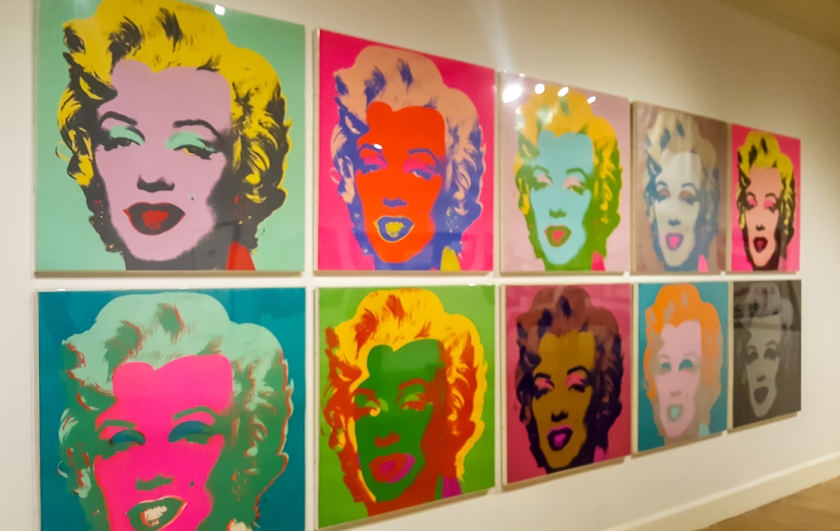
Although these images all look quite different, they are all taken from the same publicity photograph with Warhol using different colour combinations to draw attention to different features.
It is only a short walk from Modern Two, across the main road to Modern One and again, the external art work was just as intriguing if not more so than what was inside the gallery.
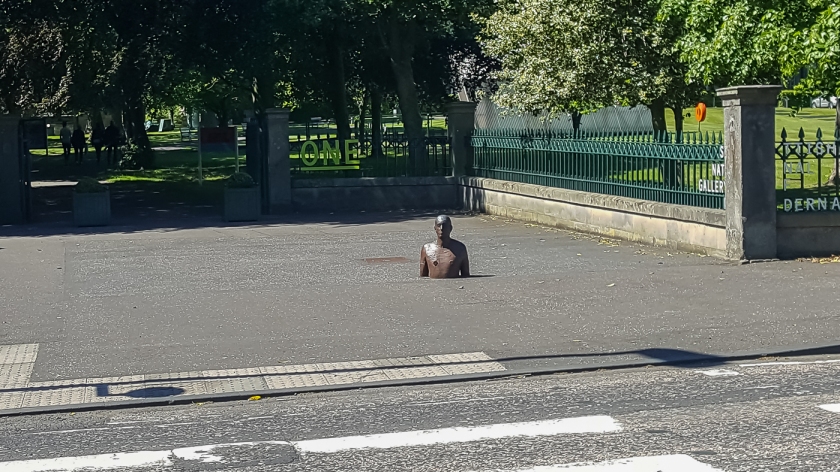
The first thing you meet is a sculpture on the pavement, Fig. 7, which turns out to be by Athony Gormley, entitled 6 Times Horizon from 6 Times. Again I knew nothing of this work until I looked it up. According to the National Galleries Scotland website, ‘6 Times consists of ‘6 life sized figures positioned between the grounds of the Scottish National Gallery of Modern Art and the sea at Leith Docks, Edinburgh’. (National Galleries Scotland, 2019) These figures are all apparently cast from the artist’s own body. Again, according to the website the work is ‘quiet and contemplative’ and encourages the viewer to think about how they fit into the landscape and environment. Without knowing any of this at the time, it struck me that here is this figure, quiet and largely ignored by people and traffic rushing past. Had I known this before I visited this gallery, I would have sought out the other 5 figures – maybe next time.
In the grounds of Modern One, are a number of other artworks. A sculpture by Eduardo Paollozi and a large land based art work called ‘Landform’ by Charles Jencks, described at Fig. 8
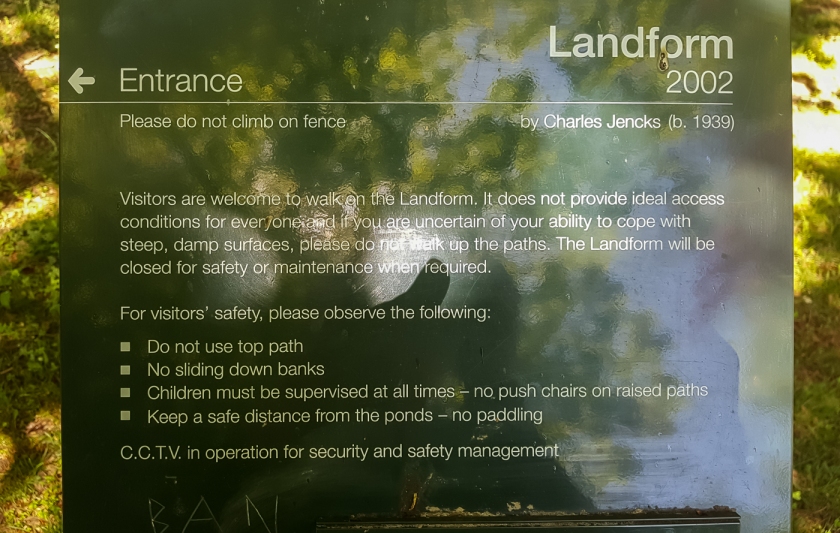
What can I say about this other than that it is amazing…
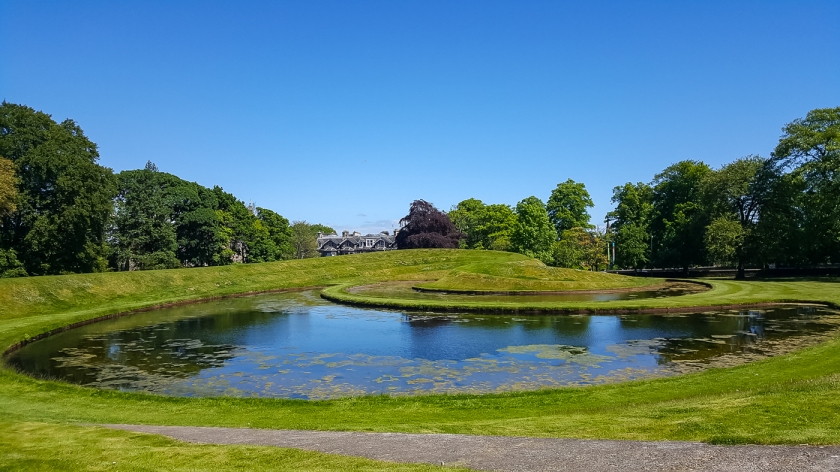
… the lake swirls right round to the centre, as does the land around it which is terraced, although that isn’t easy to see in the photographs. I found this absolutely stunning and very peaceful and for some strange reason, I recognised the name of the artist Charles Jencks. It wasn’t until I researched this further when I got home that I realised where I heard it before. Charles Jencks was the husband of Maggie Keswick Jencks, who between them founded the ‘Maggies’ cancer care centres. I spent many hours in the Maggie’s centre in Cheltenham in 2010 and 2011 and will be eternally grateful for the support I received there.
Not even in the building yet and there is another ‘text’ art work above the door…
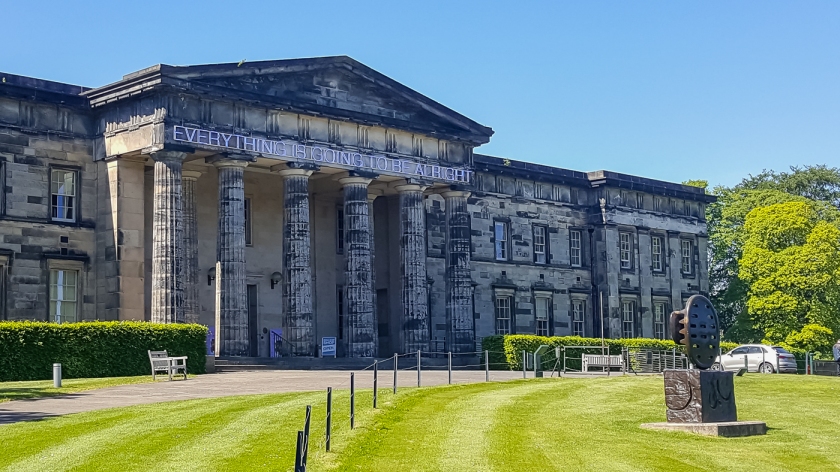
… again I assumed this to be by Douglas Gordon and again I was wrong. ‘Everything is Going to be Alright’, by Martin Creed. According to the National Galleries Scotland website, this is Creed’s work 975, (2008) although I have found it elsewhere, on Creed’s own website for example as work 203 (1999). It is described as one of Martin Creed’s most iconic works which ‘characterises his desire to communicate and interact with the viewer – to create a reaction and stir an emotion’ (National Galleries Scotland, 2019)
Scottish National Gallery of Modern Art | National Galleries of Scotland (s.d.) At: https://www.nationalgalleries.org/visit/scottish-national-gallery-modern-art (Accessed on 2 June 2019)
Once in the gallery itself, I discover that the ground floor galleries are closed as one exhibition is being taken down and another installed. Also, when I ask about Douglas Gordon’s work, I learn that it is currently in storage. Yes, I know I should have checked but it was a last minute decision to visit here. It is not quite all in storage however. There are 2 floors in this building and on the whole wall from ground up to the ceiling of the 2nd floor …
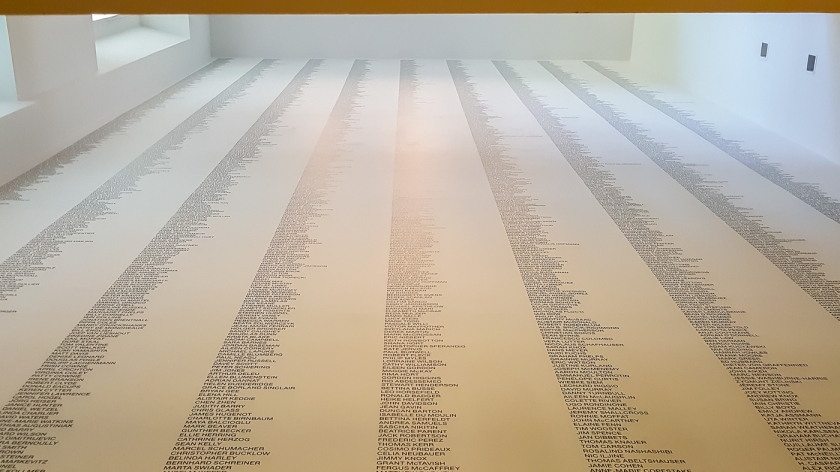
… yes, Douglas Gordon uses text in his work! The title of this work is ‘List of Names (Random) 1990 – ongoing.
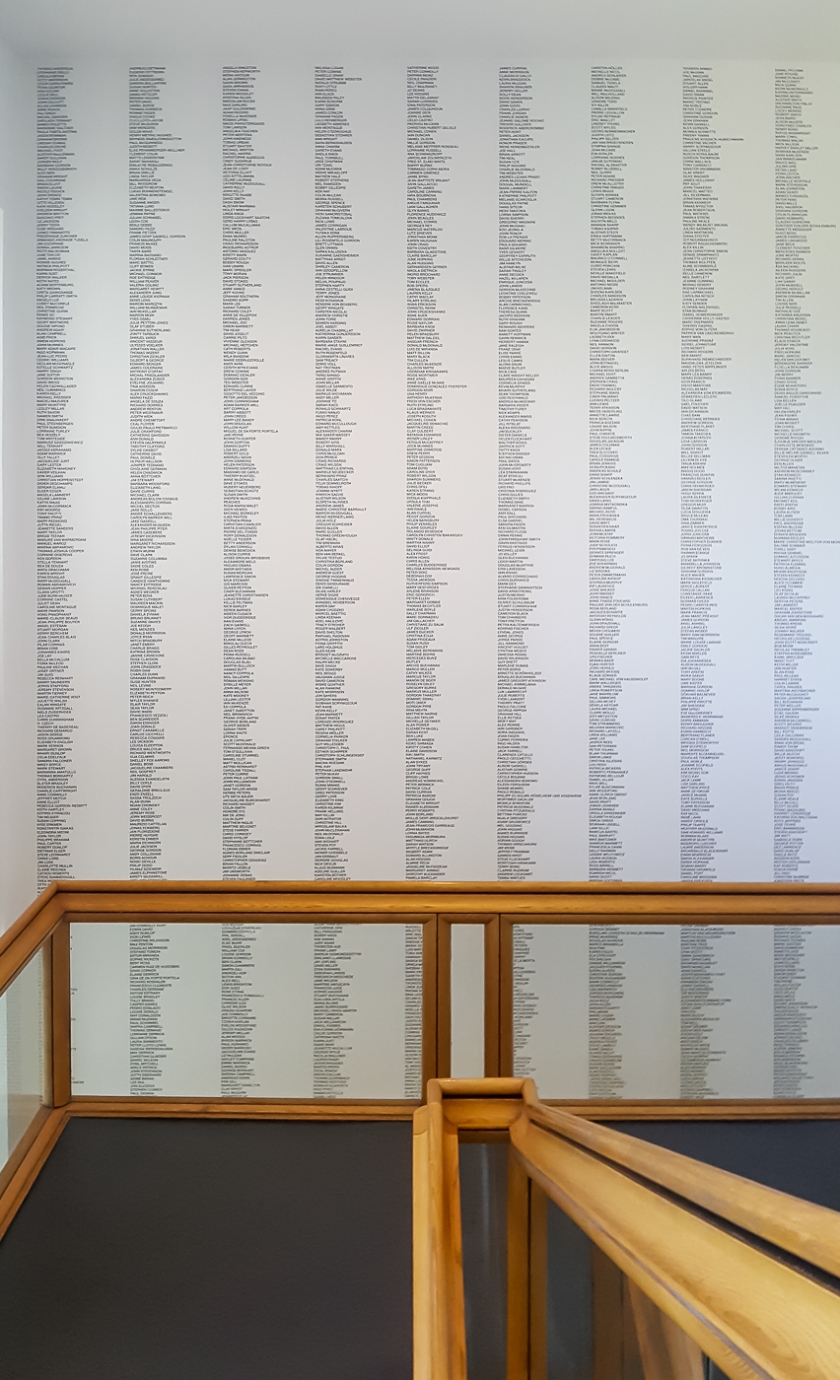
According to the accompanying text, you could be forgiven for thinking that this is a roll of honour of some sort but in fact the names are all of the people that Gordon could remember having met, which is why it is ongoing. Apparently there were 3270 names on the list when the work was installed in the gallery in 2002 and by June 2014 it had swelled to 4710. When this was started he was working on something related to cognitive ability and memory so he was effectively testing his own memory and at the time came up with 1440. Everybody I have shown this to has come up with the same response as I did when I started thinking about text and art as a topic for my critical review – is this really art? Having said that, now that I understand some of the thinking behind it, it starts to make more sense.
I thought I had done and made my way back across the road and through the grounds of Modern Two when I spotted a sign pointing towards Dean Village Cemetery, one of the oldest cemeteries in Edinburgh. Before I got there though I came across this…

… tucked round the side of the main building, Richard Long’s MacDuff Circle, 2002. There is a small plaque on the wall introducing this but I would never have spotted it had I not gone in search of the cemetery.
These are two amazing galleries which are well worth the 25 minute walk from the city centre but you have to explore because most of these treasures are not signposted. Maybe it would have helped if I had done my homework in advance or bought a guidebook but on the other hand, I have learnt so much by researching them when I got back. I have also realised that I got a lot more from the things I didn’t expect to see, particularly the sculptures and other installations than I did from the main Warhol/
Images:
Figures 1-4 and 6-13 Bryson, A. (2019) Scottish National Gallery of Modern Art, Edinburgh
Figure 5. Paolozzi, E. (1947) I was a rich man’s plaything, [Work on paper] 35.90 x 23.80 cm At: Edinburgh: Scottish National Gallery of Modern Art 17 November 2018 – 2 June 2019
References:
Nathan Coley (s.d.) At: http://studionathancoley.com/ (Accessed on 2 June 2019)
Audio Tour | Dan Graham, ‘Two Two-Way Mirrored Parallelograms’ (s.d.) At: https://soundcloud.com/natgalleriessco/gma_vitour_04 (Accessed on 2 June 2019)
Dan Graham | Artists | Lisson Gallery (s.d.) At: https://www.lissongallery.com/artists/dan-graham (Accessed on 2 June 2019)
Eduardo Paolozzi | National Galleries of Scotland (s.d.) At: https://www.nationalgalleries.org/art-and-artists/artists/eduardo-paolozzi (Accessed on 2 June 2019)
Analysis: Andy Warhol’s Marilyn Monroe Series (1962, 1967) (s.d.) At: https://news.masterworksfineart.com/2017/10/10/andy-warhols-marilyn-monroe-series-1967 (Accessed on 2 June 2019)
Antony Gormley (s.d.) At: http://www.antonygormley.com/projects (Accessed on 2 June 2019)
6 TIMES HORIZON from 6 TIMES (s.d.) At: https://www.nationalgalleries.org/art-and-artists/109183/6-times-horizon-6-times (Accessed on 2 June 2019)
mysite (s.d.) At: https://www.charlesjencks.com (Accessed on 2 June 2019)
mysite (s.d.) At: https://www.charlesjencks.com (Accessed on 2 June 2019)
Work No. 975 EVERYTHING IS GOING TO BE ALRIGHT (s.d.) At: https://www.nationalgalleries.org/art-and-artists/106670/work-no-975-everything-going-be-alright (Accessed on 2 June 2019)

